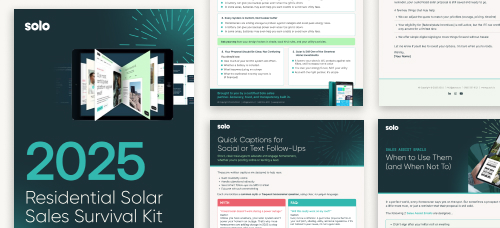The Big Beautiful Bill (H.R. 1) marks a significant turning point for the residential solar industry. Residential solar contractors across the country have to reassess their strategy.
With the 30% Residential ITC ending and new timelines redefining deferral incentives.
The best teams didn’t panic. They’ve adapted, and they’re still closing deals, protecting their pipeline, and positioning themselves to win through 2026.
We broke down what those teams are doing differently and how you can put the exact strategies to work.

Why the Smart Contractors Didn’t Panic
When the rules changed, top contractors didn’t wait around for clarity. They adjusted quickly and purposefully—recognizing that, in a post-ITC market, success depends on more than speed. It requires a modernized solar sales process and tighter internal alignment.
Quality and compliance became non-negotiable. Speed alone doesn’t close deals or set teams up for long-term wins. The expiration of §25D wasn’t a dealbreaker but a cue to rethink strategy and move with intention. And in a high-pressure, time-sensitive market, a smooth customer experience and tight operational alignment became critical advantages.
Rather than scramble, they used the moment to sharpen their systems.
10 Smart Moves We’re Seeing Now
1. Re-train solar sales reps on storage and tax credits:
Leading contractors are running refreshers on how to sell long-term value. Teams are learning to explain storage incentives, TPO eligibility, and what homeowners can expect without the 30% ITC.
2. Rebuild install timelines to beat permitting bottlenecks:
They’re adjusting their internal calendars to prioritize speed to PTO. They avoid costly delays by working backward from deadlines and anticipating local slowdowns.
3. Prioritize homeowner education in the sales cycle:
Sales cycles are getting longer, but these teams use that extra time wisely. Educational tools and transparent proposals are helping homeowners feel confident, not pressured.
4. Offer post-sales service and maintenance plans:
Service matters more when customers feel uncertain. Top teams are rolling out post-sale maintenance options to keep systems running smoothly and build long-term trust.
5. Align proposals with AHJ-specific compliance rules:
Contractors are getting hyper-local. Tailoring designs and documentation to local permitting requirements is helping them avoid rework and speed up approvals.
6. Emphasize accurate solar system design to reduce change orders:
Precision up front saves time and revenue downstream. Verified system designs mean fewer surprises, stronger lender relationships, and smoother installs.
7. Simplify solar financing conversations:
These teams know that confused buyers don’t sign. They’re reframing solar financing as a gateway to energy savings and breaking down options in clear, digestible ways.
8. Update proposal templates to reflect new tax credit timelines:
They’re not relying on outdated incentives to sell. Instead, they’re building proposals that clearly show what customers can expect in current and post-ITC scenarios. See how to talk about solar tax credits.
9. Build local solar marketing campaigns:
Rather than sticking to generic messaging, smart contractors are tailoring ads and education tools to reflect local incentives, electricity rates, and utility policies.
10. Track better KPIs to measure what’s actually working:
Elite teams are closely monitoring what actually works. They track change order rates, proposal accuracy, and close ratios to guide smart, scalable growth.
3 Quick Wins to Improve Your Solar Sales Strategy Today
Here are three quick ways to level up your approach now:
- Audit your current proposal flow. Are you clearly showing updated timelines and incentive eligibility? Make sure your templates reflect today’s real-world conditions.
- Build a local incentive cheat sheet. Even if you start with just your top three markets, this helps reps close confidently and educates homeowners faster.
- Host a team huddle focused on solar and storage. With §25D ending, pairing panels with batteries is one of the best ways to deliver long-term value and future-proof deals.
Your Next Move: Tools That Help You Sell Smarter
The teams staying ahead in 2025 aren’t winging it. They’re using tools, systems, and insights built for this exact moment in solar.
Our comprehensive 2025 Residential Solar Sales Survival Kit includes proposal templates, updated incentive breakdowns, and field-tested tactics for navigating post-ITC changes with clarity not chaos.
It’s what the most effective teams are using to reduce change orders, close faster, and keep operations aligned. Download the Kit and see how your strategy stacks up.
Just Launched: DirectDesign 2.0
DirectDesign 2.0 is now live, a cleaner interface, updated UI and powerful new tree editing tools for faster, more accurate solar system design.
Explore what’s new in our Interactive Demo.


